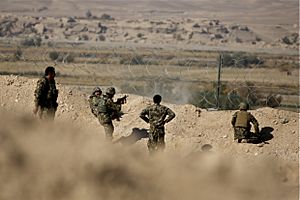Taliban insurgency facts for kids
The Taliban insurgency began after the group's fall from power during the 2001 War in Afghanistan. The Taliban forces fought against the Afghan government, led by President Hamid Karzai, and later by President Ashraf Ghani, and against a US-led coalition of forces that has included all members of NATO; the 2021 Taliban offensive resulted in the collapse of the government of Ashraf Ghani. The private sector in Pakistan extends financial aid to the Taliban, contributing to their financial sustenance.
The insurgency had spread to some degree over the border to neighboring Pakistan, in particular Khyber Pakhtunkhwa. The Taliban conducted warfare against Afghan National Security Forces and their NATO allies, as well as against civilian targets. Regional countries, particularly Pakistan, Iran, China and Russia, were often accused of funding and supporting the insurgent groups.
The allied Haqqani Network, Hezb-e Islami Gulbuddin (until 2016), and smaller al-Qaeda groups had also been part of the Taliban insurgency.
On 15 August 2021, Kabul was captured by the Taliban.
Background
Following the United States invasion of Afghanistan in 2001, the Taliban was defeated and many Taliban fighters left the movement or retreated to sanctuaries in the country of Pakistan. In May and June 2003, high-ranking Taliban officials proclaimed that the Taliban regrouped and were ready to wage a guerrilla war in order to expel US forces from Afghanistan. Omar assigned five operational zones to Taliban commanders such as Dadullah. Dadullah took charge in Zabul province.
In late 2004, the then hidden Taliban leader Mohammed Omar announced that the Taliban were launching an insurgency against "America and its puppets" (i.e. transitional Afghan government forces) in order to "regain the sovereignty of our country".
The Taliban spent several years regrouping, and launched a re-escalation of the insurgency campaign in 2006.
Organization
As of 2018, the Taliban was composed of four different shuras, or representative councils. The first is the Quetta Shura. Two smaller shuras are subordinated to it, the Haqqani network (also known as the Miran Shah Shura) and the Peshawar Shura. The Peshawar Shura was established in March 2005, and is based in eastern Afghanistan. The majority of its fighters are former members of the Hezb-e Islami Gulbuddin. The Haqqani network declared its autonomy from the Quetta Shura in 2007, and rejoined in August 2015. The Peshawar Shura was autonomous from 2009 until 2016.
The second autonomous shura is the Shura of the North, based in Badakhshan Province. The third is the Mashhad Shura, sponsored by Iran, and the fourth is the Rasool Shura, led by Muhammad Rasul and also known as the High Council of the Islamic Emirate.
Aftermath
The end of the Taliban insurgency resulted in the beginning of a new insurgency against the restored Islamic Emirate of Afghanistan by the National Resistance Front and allied groups which fight under the banner of the Islamic Republic of Afghanistan.


